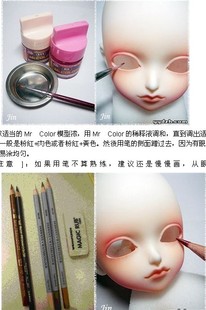Before the real introduction, here's something about this blog and myself:
I started this blog for my information system assignment.(=_= boring, i know) It requires me to post 4 blogs each month about anything I'm insterested in.
Being a big fan of BJDs and because of there's really nothing else to talk about , I decided to write a BJD blog to help people get more information about it.
I will post about some basic knowledge of BJD, any interesting news of the BJD companies, as well as some pictures of my own dolls.
Hopefully I can get some attention any maybe I will keep updating this blog after the lecture ends.=OwO=
-----------------------------So the BJD101 class starts------------------------------
1. What is BJD?
Here's a description from Wikipedia: "A ball-jointed doll is any doll that is articulated with ball and socket joints. In contemporary usage when referring to modern dolls, and particularly when using the acronyms BJD or ABJD, it usually refers to modern Asian ball-jointed dolls.[1] These are cast in polyurethane synthetic resin, a hard, dense plastic, and the parts strung together with a thick elastic. They are predominantly produced in Japan, South Korea and China. The BJD style has been described as both realistic and influenced by anime" BJD was originally from in Europe, then Japanese artists started to develop a new style combing the traditional Japanese doll and the ball-jointed doll. It was not untill 1999 when the Japanese company Volks started to sell the kind of BJD that we are familiar with now in the market, and the business expended fast that many Korean and Chinese companies joint the market in the following years. You can read more about the history here:
An official photo of Elf Ducan, a BJD produced by a Korean company D.O.D
2. What can you do with your BJD?
You can move the BJD's joints to make different poses. You can also change the eyes, the wig, the clothes, and the make up on the doll. Normally the doll doesn't come with the make up unless you ordered it, which means it doesn't have eyebrows, no lip colors nor eye shadows. You can either get it done by yourself or find someone who's good at it. There are many people who take doll make up orders and each artist has his or her own style. If you like you can also change the body parts of your doll, for example, put a boy's head on a girl's body......Some companies also produce doll parts such as jointed hands which you can even move the fingers, elf/cat/rabbit ears, and wings.
(A picture from a face up tutorial for BJDs)
3. The types and sizes of BJDs.
Most common sizes of BJDs are:
1/3 scale-->roughly ranging from 50cm to 65cm
1/4 scale-->ranging from 40cm to 47 cm
and 1/6 scale-->ranging from 20cm to 30cm.
There're also some other sizes:
full adult size of about 70cm-->this is getting really popular
1/8 scale-->dolls between 10cm to 20cm.
1/12 scale-->These are really tiny dolls that are smaller than your hand, not many companies are producing them yet
You can find female BJDs and male BJDs, and some companies like VOLKS also have BJD body that has no male feature nor female feature (the "angel" body type). Besides human BJDs, lots of companies are also producing animal BJDs and fairies.
-------------------------------------------------------------------------------------------------------------------
That's it for the first lecture of BJD 101!
Next time there will be some introductions and links of BJD companies!
o(≧v≦)o



No comments:
Post a Comment